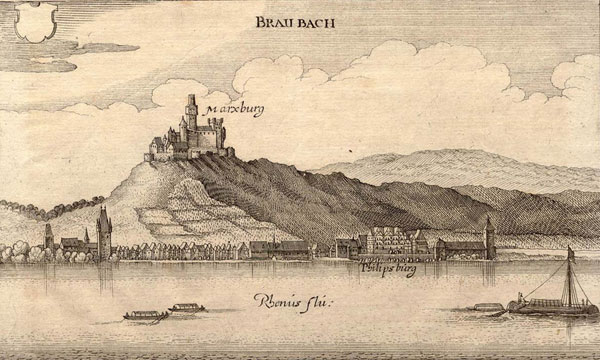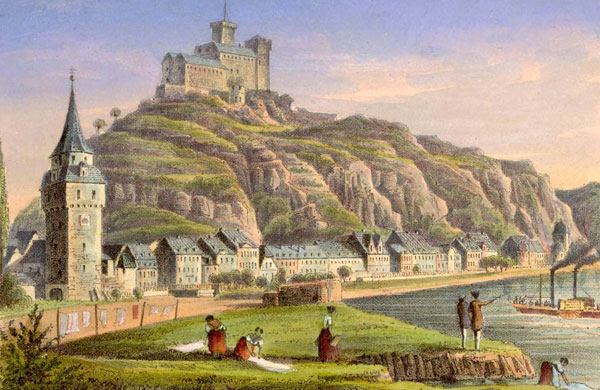|
|

It may be assumed that the Noble
Freeman of Braubach mentioned in the archives dating from 1117-1171,
were most likely the owners of an already existing castle complex, or at
least of a representative residence (the exact location of which is not
known) in the town of Braubach.
The first entries of the Lords of Eppstein into the
archives can be traced back to 1219. They had been given Braubach
and its lucrative silver mines as fiefdom by the Count of Palatine. The
core of the present castle (“Kernanlage”) was erected in the early 13th
century under the reign of the Lords of Eppstein. Earliest evidence of the
existence of the castle dates from 1231. As so called “Castellani”, which
means castle folk, attain first mention in the archives. According to
recent research, the wood which was axed in 1239 was actually used to
build the lower parts of the castle keep of the castle, thus substantially
verifying the existence of the castle. Whether the entire castle was built
at that time or whether the keep was incorporated into an already existing
complex cannot be determined. However, glass fragments were found in the
courtyard during a smaller survey in 2004. These fragments suggest the
usage of the courtyard around 1200.
Nevertheless, in 1260 the castle is mentioned as fortified toll station
(“Zollburg”) in the archives. 1276 the town of Braubach
receives its municipal rights.
In the year 1283 the counts of Katzenelnbogen, who were
consequently expanding their territories, take Braubach and the castle
into their possession. In turn with the Hohenstein Castle in the Taunus,
the castle most probably served as residence for the descendants of the
Counts of Katzenelnbogen. 1293 the Count of Palatine presents the castle
to them as fiefdom and thus confirms ownership.
Following the death of the last Count of Katzenelnbogen in 1479,
the castle was subsequently passed onto the Earls of Hesse.
According to historians the only Earl who is of any significance is Count
Phillip II. Count Phillip II preferred the newly constructed
Phillipsburg, built just below the Marksburg (which derives its name from
Mark as patron of the 1437 consecrated castle chapel). He eventually
abandons the Marksburg and moves his residency to the Philippsburg.
In 1803 the poorly maintained castle was finally passed into the
possession of the Duchy of Nassau. In 1866 it was taken over
by Prussia.
In 1900 the castle was bought by the German Castle Association
(founded in 1899), the castle became the seat of their headquarters and
offices, it remains to be that way until today. |
|
|
The architectural history of the
Marksburg has been authenticated since it was purchased by the
“Association for the Preservation of German Castles” (since 1954 DBV), in
the late twentieth century and through recent research done in the
1980ies.
The north facing Great Hall and the south eastern Rhine facing part of the
wall, which includes the Rhine-Wing and the Chapel Tower (height: 9,80m
and ending with the outer ward), are all associated with the late
Romanesque fabric of the castle complex. The building of these
architectural structures was initiated by Gerhard von Eppstein.
According to dendrochronological analysis, the construction of the tower
dates back to the year 1372. It is estimated that almost simultaneously
the in 1239 erected square keep was raised by a floor and furnished
with a slender turret.
The Romanesque Great Hall (“Palas”) was partially demolished and
subsequently replaced by a contemporary gothic structure. As
dendrochronological analysis have confirmed, the Gothic Hall
(“Gotischer Saalbau”) was built north-easterly from the Chapel Tower in
1435. Around 1300 the Castellan’s Tower (“Burgvogtturm”), as
well as the indented gate and an outer bailey were all constructed to
reinforce the main castle.
The second phase of gothic development (mid 14th century) led
to the construction of the Iron Gate ("Eiserne Tor" )and the Gate of the
Fox ("Fuchstor").Towards the end of the 14th century the Goat’s
Bailey (“Geißenzwinger”) was built on the eastern side of the main castle.
Marking the beginning of the 15th century was the construction
of the outer bailey, semi and three-quarter circular half towers and the
building of the Drawbridge Gate”.
The reconstruction of the castle in the post mediaeval times (1643-1645)
was conducted by John the Belligerent Earl of Hesse (+1651). His
external architectural structures include: the Lower battery (near the
drawbridge), the Bastions Powder Corner (“Pulvereck”) and Sharp Corner
(“Scharfes Eck”). Towards the north of the castle, the battery of cannons
(“Geschützhaus”) was extended by the “Great Battery” in the 16th
century.
Dendrochronological research shows that the Rhine-Wing (“Rheinbau”)
was built in 1704-1706. The last adjustments to the northern
structure (late Romanesque Great Hall) were made in 1708, the Hall
was raised by a floor.
The slender, round turret of the castle keep was removed in 1706 and
replaced in 1905, just above the lower battery the Castle Tavern,
constructed in 1929. |







